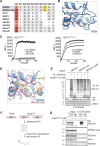Structure-based design of potent and selective inhibitors of the HECT ligase NEDD4
- PMID: 40437006
- PMCID: PMC12119865
- DOI: 10.1038/s42004-025-01557-4
Structure-based design of potent and selective inhibitors of the HECT ligase NEDD4
Abstract
Among the human E3 ubiquitin ligases, NEDD4 (Neural precursor cell expressed developmentally down-regulated 4) plays a critical role in development and cancer, making it a compelling therapeutic target. However, no specific NEDD4 inhibitors have advanced in drug development. In this study, we reveal the inhibitory mechanism of Norclomipramine, a tricyclic antidepressant, which inhibits NEDD4-mediated ubiquitin chain elongation by binding to a hydrophobic pocket in the Ub exosite of the N-lobe. Building on this mechanism, we conducted a focused medicinal chemistry campaign, resulting in the development of covalent inhibitors that specifically target the non-catalytic cysteine C627. These compounds exhibit selective binding to NEDD4 over other family members, effectively inhibiting NEDD4-mediated polyubiquitination while leaving monoubiquitinated substrates unaffected. Among these, compound 32 emerged as a potent lead (IC50 = 0.12 µM) with favorable pharmacokinetic properties, including oral bioavailability, paving the way for future in vivo efficacy studies.
© 2025. The Author(s).
Conflict of interest statement
Competing interests: R.A., G.F., E.M., C.M., M.P., S.Pa., S.P., L.S. and M.Va. are patent co-inventors for “Hect E3 Ligase Nedd4 Inhibitors and uses thereof” (EP3976185B1). The remaining authors declare no competing interests.
Figures





References
-
- Stewart, A. K. et al. Carfilzomib, lenalidomide, and dexamethasone for relapsed multiple myeloma. N. Engl. J. Med.372, 142–152 (2015). - PubMed
-
- Soucy, T. A. et al. An inhibitor of NEDD8-activating enzyme as a new approach to treat cancer. Nature458, 732–736 (2009). - PubMed
-
- Utecht, K. N. & Kolesar, J. Bortezomib: a novel chemotherapeutic agent for hematologic malignancies. Am. J. Health Syst. Pharm.65, 1221–1231 (2008). - PubMed
Grants and funding
LinkOut - more resources
Full Text Sources

